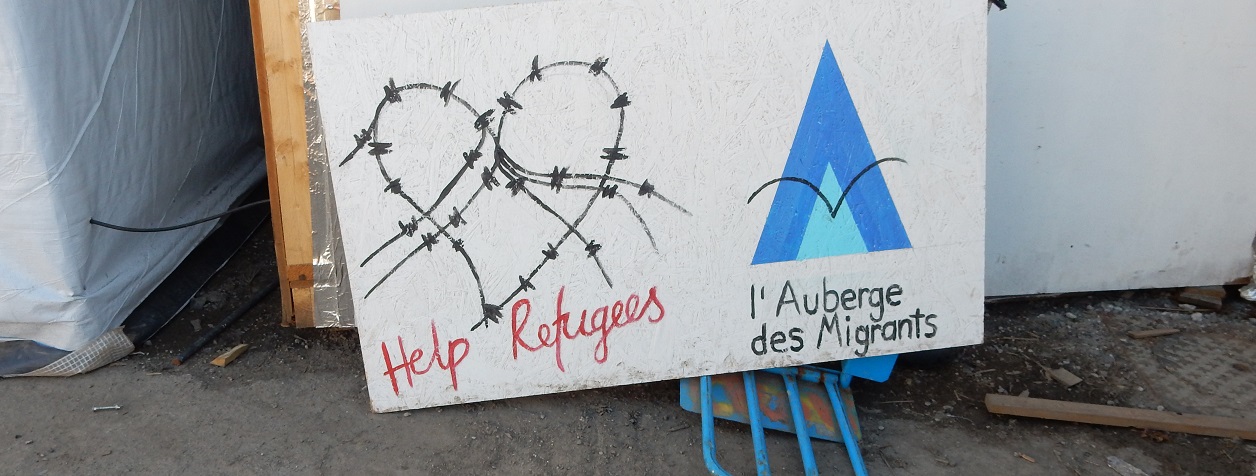By Phil Kerton, Seeking Sanctuary
I set off to drive to Dover on the last day of November to make my first visit to Calais since the destruction of the ‘Jungle’ camp. The temperature was permanently below zero as I headed East along the A2 and M2, with the blinding morning sun ahead of me. I had already packed goods from a variety donors into the car and met up with Ben and his son to add an even larger quantity, principally collected by the people of St Aidan’s church in Coulsdon. Ben also handed over a large amount of cash which had been raised in recent weeks to support the continuing work in Calais.
The sky over the Channel was clear, with the French coast already in sight from the harbour and, thankfully for this season, the sea was as flat as the proverbial millpond. On the reaching Calais the temperature had risen by ten degrees Celsius – quite the reverse of the usual cross-Channel pattern in winter months.
My plan was to visit a number of associations who we had assisted over the previous eighteen months and find out how things had changed and what their vision was for the future. My first stop was the Catholic Worker house – a chance to meet some people face-to-face for the first time. The House – the first Catholic Worker house in France – was set up in February 2016. It’s a large “house of hospitality” that works with volunteers in Calais to try to help some of the most vulnerable people.
An important part of its mission has been to help organise emergency hospitality to the most vulnerable, such as families with children; unaccompanied minors; refugees with medical needs or who are recovering after treatment; pregnant woman, and all at risk of exploitation. Also visiting people in hospital and being alongside lonely refugees. The Eritrean icon artist, Henok, has spent time there and they are looking after some of his work. A few weeks ago there were six visitors, but the number “visiting” was down to two when I arrived, with at least six more being visited in hospital.
Volunteers live simply, in community with their visiting refugees and migrants, and are actively involved in prayer and work for peace and justice. Its coordinator is a Dutch Protestant brother, Johannes Maertens. I was delighted to hand over a sum of money to help with the expenses of running the house, along with sufficient “little bags of hope” – the first to be distributed this year – to provide a festive present to all those that they were currently helping.
My next stop was not far away, at the new Secours Catholique “migrants’ locker-room” whose opening had been delayed for close to a year by wrangles over compliance with various regulations. The eventual result is a splendid resource where they can welcome their migrant friends in a different setting, in a more dignified way away from squalid shelters and muddy fields. Clothes can be selected at a counter where there is no need to queue and where choices are available. Shelves are currently being stocked with winter clothes, footwear and bedding in the firm expectation that, as in the past, numerous clients will return during 2017. For the time being they get just the odd visitor, new arrivals and people staying for medical treatment, or with leave to remain while asylum applications are processed. Goods can be sent to other places where there is a demand, if the shelves eventually get full.
Those working there were able to confirm that they will be pleased to distribute our “little bags of hope” when we have accumulated a good supply – probably to people in the Grande Synthe camp near Dunkirk. I handed over a small supply of bags for them to give their next few visitors and headed off towards the warehouse run by the Auberge des Migrants and Hep Refugees.
My route took me along the port access road to the business estate best known in the UK for its discount wine and beer outlets. Workers were busy erecting the “great wall of Calais” alongside the section of the road that had not been fitted with extra-high security fences and razor wire. This is allegedly intended to abate traffic noise and not to keep migrants off the carriageway, but it is still being erected where the land alongside the road dips down to a much lower. As I drove in at tortoise pace in a queue of HGVs on the carriageway that was not closed to allow the construction work, I pondered the structure, reported to be consuming some £1.9 million of UK aid, and wondered if its designers might soon be bidding to wall off Mexico from its northern neighbour.
To add to my anger I found that the builders had closed the exit slip road that I had intended to use, sending me off on a circular trip of several extra miles!
The warehouse also houses the Calais Community Kitchen, where volunteers were still working hard preparing food, mainly destined for Dunkirk. I get the same report in each place that I visited: numbers at Dunkirk, which had dropped to around 500 a month or so earlier, had shot back up during November, passing the 1,500 mark by a wide margin, now probably hovering near 1,800. This was another place where I handed over a welcome sum of cash. Donations and supplies of ingredients are arriving much more slowly now that the ‘jungle’ has been razed: please people, they are still needed! And the same is true at the neighbouring warehouse which last month distributed 21,000 items to people in Dunkirk, Paris and accommodation centres across the country.
My final visit was to the Care4Calais warehouse, located in Blériot-Plage on the edge of the town. Rather than trust my instinct and speed along the autoroutes, I asked my SatNav for a fast route and found myself in a sequence of traffic jams close to the town centre. There are still plenty of riot police hanging around beside strategic roads and on street corners. They are quick to question anyone who they believe looks like a migrant and demand to see their papers. If there are any problems, then it’s straight into a van to be carted off to detention somewhere.
Handing over the boxes and bags of donations (all very well labelled to assist the warehouse operations), I met a volunteer who had just spent a week in Paris. He confirmed what I had heard on my three previous calls that day: there are hundreds of people sleeping in the open on the streets of the capital. Informal camps have been cleared in recent months and no more are allowed to develop. The capacity of new “reception centres” is inadequate, and the maximum permitted stay is only some ten days.
Temperatures have been down to seven degrees below zero. There is a desperate need of tents, including pop-up designs that can be used on pavements. Other major needs are warm hats, gloves and scarves, along with men’s winter clothes in sizes S and M, and new underwear.
So, to sum up, everyone in Calais is preparing for numbers to increase again. Will this be from the brand new arrivals, still turning up in their dozens each week? Or from those – including children – who are dissatisfied with their accommodation in remote respite centres and who have disappeared? Or will those who have not applied for asylum in France be thrown out of the centres and wander back to the Channel coast? Or do the authorities want to keep the numbers in Calais down to a minimum until after second round of the Presidential elections in May 2017?
Meantime, there is the Dunkirk camp to supply, and there are many thousands in respite centres across France, some of who lack some essentials. Calais can act as a hub to supply all of these and any surplus goods can be packed on pallets to be added to vans on their way to refugee camps in Greece.
And spare a thought for the long-term volunteers, who are all pleased that the ‘jungle’ has gone – though not with the manner in which it was demolished – and who are suffering the bereavement of finding a hole in their lives and losing the friends who they had helped for months on end.
And for my own short day of “tourism”? On my way back to the port I snatched up a couple of bottles of Christmas cheer, which I will see consumed with guilt, when remembering what other people need in order to merely survive. (Perhaps I’ll find the excuse to talk about the circumstances in which I happened to buy them?) And I managed to make it on to an earlier ferry and discover that a cousin and her husband were among my fellow passengers. Calais seem to be an extension of London for those who live in the South East, but what a terribly different place it has been for the past year and a half.
As for 2017? Those on the ground in Calais are preparing to do their best to provide aid, whatever scenario develops. If only the politicians of Europe would choose to follow their lead.
The views expressed in this blog are not CSAN policy.

